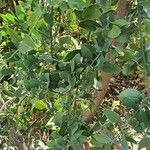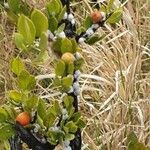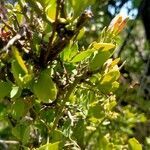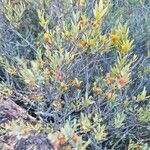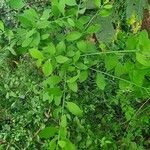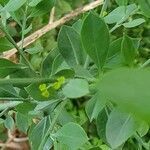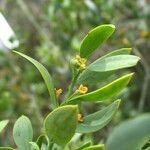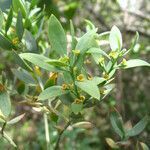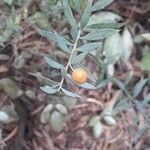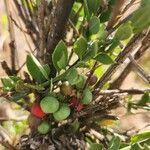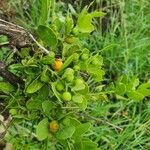Rock tannin bush; bergbas (A); morogabaloi (T); umbulunyathi (X, Z) Small tree or shrub, 1.5-4.0 m high; androdioecious. Leaves elliptic to oblong. Inflorescences with flowers occurring in 2-or 3-flowered dichasia. Perianth yellowish green. Disc ± flat, angled between stamens. Flowering time Oct.-Feb. Fruit an ellipsoid drupe, crowned with persistent perianth lobes, yellow turning red.
Flowers either hermaphrodite or male, plants androdioecious, hermaphrodite flowers in axils of upper leaves; peduncles solitary, usually 1-flowered, occasionally flowers in 2–3-flowered dichasia; male flowers both axillary and terminal, often panicled, each peduncle usually terminating in an umbellate cluster of flowers, rarely flowers solitary or in a 2–3-flowered dichasium.
A shrub. It grows about 3-6 m high. The branches are slender and 3 sided. They hang down. The leaves have short stalks. They are alternate and 2-7 cm long by 05.-3 cm wide. They are oval. The tip tapers. The flowers are stalked. They are small and greenish. The fruit is fleshy with a hard covering over the seed. The fruit is nearly round. It is orange when ripe.
Shrub or small tree, up to 6 m high. Stems square, greyish green. Leaves alternate, subsessile; blade elliptic, ± 35 x 15 mm, apex acute, base cuneate, margins entire, greyish green with a waxy bloom. Flowers: in axillary clusters; perianth greenish yellow; Oct.-Apr. Fruit an ovoid, fleshy, bright red drupe, 8-15 x 6-10 mm.
Ovary 2–2.8 mm long, ovules 3 (rarely 4) in hermaphrodite flowers, ovules and placenta aborted in male flowers; style 0.8–1 mm long, thick, cylindric; stigma in hermaphrodite flowers normally 4-rarely 3-lobed, lobes ellipsoid, prominent; in male flowers both style and stigma aborted or rudimentary.
Leaves usually alternate, 15–65 × 7–40 mm, elliptic or elliptic-oblong, rarely obovate, apex abruptly apiculate, base cuneate, veins ± immersed, only midvein raised below and running back down stem in narrow ridge; petiole 1–3 mm long, articulated to a small cushion.
Perianth yellowish-green, leathery; hermaphrodite flowers: tube 0.5–0.6 mm long, obscured inside by disk, lobes usually 3, rarely 4, 1.5–2 × 1.8–2.2 mm, spreading, ovate-deltoid, tips slightly hooded; male flowers similar.
Shrub or small tree, up to 6 m high. Leaves narrowly to broadly ovate, greyish green, alternate. Berries bright red, 8 x 6 mm. Flowers greenish yellow.
Fruit 5–6.5 mm in diameter when dry, ellipsoid, epicarp thin, fleshy, red when ripe.
Stamens normally 3, rarely 4; filaments 0.5 mm long; anthers 0.5 mm long.
Bracts and bracteoles c. 1–3 mm long, linear-lanceolate.
Shrub or small tree, 1.2–6 m tall, all parts glabrous.
Peduncles 4–28 mm long.
